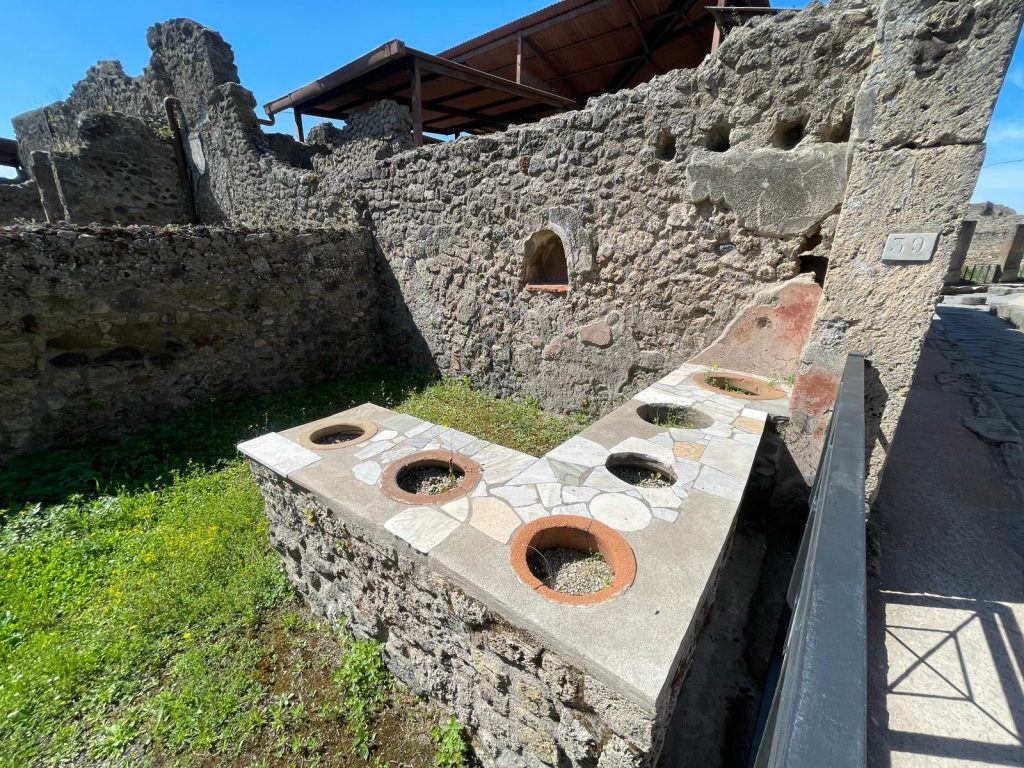When the city of Pompeii was buried under ash from Mount Vesuvius in the year 79 CE, there were about 1,000 commercial establishments. At the time of the eruption, Pompeii had around 20,000 inhabitants—that is, roughly 5 establishments per 100 inhabitants.

Concentration map of hospitality establishments in Pompeii.
Thermopolium at the corner of Via di Nola and Vicolo di Lucresio Frontone. Photo: David Nogué.
Compared with today’s Catalan cities, such a level of commercial provision is found only in top-tier urban retail centers. Barcelona’s Eixample, for example, has about 5 establishments per 100 inhabitants—the same as Pompeii. Ciutat Vella has more than 6. Girona’s Mercadal neighborhood has more than 12. In Pompeii, as in Barcelona, there are more than 1,000 establishments per square kilometer. In central London, fewer than 500.
Visiting Pompeii, it’s striking how identifiable the commercial premises are—and in most cases, the activities inside them as well: laundries, bakeries, food shops, ceramic workshops.
And bars—many bars. The bars of Pompeii are the easiest establishments to identify. In total, we counted 101 thermopolia, the Greek term Romans used for what we would call bar-restaurants. Thermopolium (plural thermopolia) comes from thermos, “hot,” and polein, “to sell.” In short, they were shops that sold hot food.
At the thermopolia you could eat and drink—at the counter or seated at a table—or take food home. They were, in effect, a kind of bar-restaurant–fast food. At the entrance of each you find a counter with holes in the countertop where pots of hot food were set. In the back room, amphorae have been found that once held wine, and ceramic jars that contained defrutum, the grape reduction added to wine to offset its vinegary taste, caused by the lack of preservatives. The long boiling of defrutum in large lead pots for days on end has recently been linked to possible outbreaks of lead poisoning in ancient Rome—a partial explanation for the erratic behavior of emperors like Caligula or Nero, both known as fervent devotees of Bacchus, the god of wine.
Like other Pompeian shops, the thermopolia occupied the street frontage of Roman villas (domus) on either side of the doorway, as well as the ground floors of apartment blocks (insulae). The shopowners were the same patricians who lived in the villa. Putting businesses on the frontage brought several benefits: the income from the shop itself; the flow of customers, which helped them gather information and keep up with the rumors of today that would be tomorrow’s news; and, finally, the activity at the entrance served as protection against intruders. The alternative was keeping guard dogs in the courtyard.
The bars of Pompeii, then, accounted for 11% of all commercial establishments—exactly the same share as bars in the city of Barcelona. If we add the rest of the hospitality sector—cauponae (inns of the time) and the lupanar (let’s not forget)—the total would come to around 13% of all establishments in the city. In Barcelona, hospitality as a whole represents 19.5%; in Girona, 16.4%.
In Pompeii, as in Barcelona and Girona, there was a bar on every corner. A pattern this persistent over time suggests that a high presence of bars in a city is not a problem. Rather, if there isn’t a bar on every corner, something’s not right.
